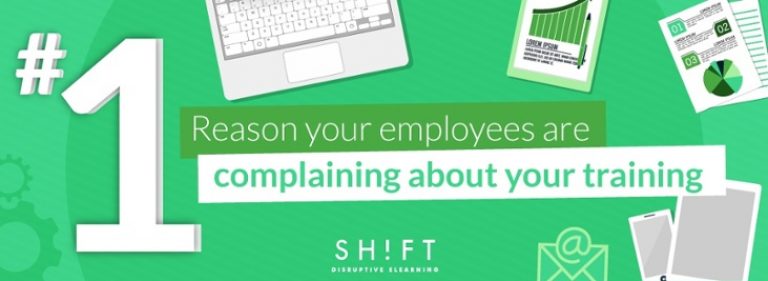Your company has just upped the training budget and rolled out a new set of eLearning courses. You are upbeat and confident that these courses will help your employees be on top of their game. And then comes this shocker: the surveys reveal that your employees think your courses are not hitting the mark. They report not feeling motivated to take them. Worse, many amongst those who went through the training felt they wasted their precious minutes and hours.
Can you fathom what went wrong? After all, you invested so much time, effort, and money into their development. It is natural for you to want to know before you launch a new set of training programs.
According to the findings of a study published in the latest 2016 CLO report, 45 percent of workers reported that the training they go through is not relevant to their job needs. This is a piece of statistic that will make every training manager around the world sit up, shudder, and wonder aloud, “Have we been creating and dishing out content worth hundreds and thousands of dollars for nothing?”
As a training professional, you have to realize that employees are today overwhelmed by the amount of content that they have to take. The best way to make them productive and keep them on top of their game is NOT to roll out more courses that only contain a lot of nice-to-know information, but to create courses that provide RELEVANT job-related knowledge.
Here’s what you can do to ensure that the relevance of your eLearning content is clear to your workers:
1) Curate Content
There are 4 million search inquiries on Google every minute. 2.5 million posts are uploaded on Facebook every minute.
And this is just the tip of the iceberg. There are WhatsApp messages, tweets, Instagram pictures, blogs, and all the newsletters that land up in your inbox. Content overload is a burdensome reality in this age of technology.
You probably have tons of material you’ll like them to learn. But, don’t make your learners go through this grind and the frustration of sorting through the noise in your company’s learning center. Become an efficient curator who digs up, filters, and zeroes in on the most effective and relevant content for learners. And be prepared to modify information you curate to have the MOST updated information for employees up and running throughout the year.
Pick and recommend content in a variety of formats—articles, eLearning courses, webinars, podcasts, infographics, and videos. This makes the learning experience fun and ensures learners are always excited to click open a learning resource that you have recommended.
Content curation facilitates learning and increases engagement by providing easy access to relevant information just at the moment of need.Read more on this topic in this article.
Additional reads:
- The Art of Content Curation
- Content, curation and connection: The changing role of the learning designer
2) Create Actionable Content
Truth is modern employees tend to determine the worth of an organization based on the learning opportunities the company provides. They have clear goals. They want to take an eLearning course that diversifies their skillset, improves knowledge, teaches them a new skill, and/or provides productive tips that help them excel in their jobs. They DO NOT have the time to sit through “fluffy and nice-looking” eLearning courses just because these are mandatory. What’s in it for me? Why should I take the trouble to go through this course? How will this course help me do my job better? What am I expected to do after I take this course ends?
Your learners are bothered by these questions. You must answer these satisfactorily to make them go through the entire course.
It is imperative that your courses scream ACTION and ooze RELEVANCE from all pores. When your eLearning content isn’t actionable, your learners don’t see it as useful or relatable to their lives.
Here’re what you can do about it:
- Underline the context by stating clearly why the course is relevant to the employee. In other words, make the ‘What’s in it for me? clear.
- Titles and introductory paragraphs should mention what the takeaways are. This is that all-important hook that will keep learners curious and interested and willing to read on to find out for themselves and benefit.
- Guide learners on how to apply the learning when they go back to their desks.
- Cite specific examples that have a direct bearing on the tasks that the learner has to carry out after he or she is back at the desk.
3) Carry Out a Thorough Training Needs Analysis
To create the right content, in the right format and to deliver it via the right medium to the right people, you have to carry out a Training Needs Analysis. The insights you gain from this initial analysis will help you ensure the following:
- The course contains ONLY relevant content that your audience cares about. Just imagine how frustrating it is for workers to go through a whole course and yet leave with unanswered questions. These 27 Questions Will Help You (Really) Know Your Learners
- The course is driven to improve the skills and knowledge they really need to excel in their job.
- Deliver the training at a frequency that doesn’t overwhelm the learners or makes them forget what they had learned in the previous session.
- Deliver the learning via a medium that your learners find most convenient to access and use.
- Depending on their preferences, access to digital communication devices, and the amount of time they can take off from work to learn, you can deliver the learning through the web, via the smartphone or tablet, in a classroom training session or workshop, or over the snail mail.
4) Offer Just-in-time Resources
As a training professional you have to ensure learners close their knowledge gaps. But you have to do this on their own terms.
Modern learners value learning for the sake of the benefits it confers on them—improved skills, increased productivity, greater self-worth, and more relevance in the job market.
These learners don’t have the time to take a course when YOU want them to. They want to have easy access to learning resources when THEY can and want, which is when their job demands.
To provide value, you have to be there when your learner is stuck on a task and wants to look up a checklist or is about to approach a customer and wants to learn about the specs of the product he is about to market.
That’s why you have to provide just-in-time resources. Employees are demanding learning experiences that bridge the chasm between content and the actual work, and to them, this is the mark of relevance.
BUT, before you start developing “Just-in-time” learning content, here are the critical initial steps:
- Learn about typical job roles and responsibilities of your learners. More importantly, learn what tasks they are expected to perform at the workplace.
- Find out about the common challenges they face while carrying out these tasks.
- Figure out which of these challenges can be addressed through just-in-time learning resources. This step is necessary because some knowledge gaps can be bridged only by bringing about a change in learner behavior, which is a lengthy process and merit face-to-face interactions with the trainer.
Also, keep in mind the following tips, so you ensure you always create relevant training content:
- Learn about the operations and business goals of your organization, so you can decide what skills and knowledge employees need to bring to the table to improve the business bottom line.
- Educate your learners about their job responsibilities and the skills and knowledge that they are expected to possess. This ensures they can themselves take charge of their learning and evaluate a course for relevance.
- Establish and reinforce throughout the eLearning course the direct association between the training content and how it can be applied on the job. Here’s why it is so important to harp on the relevance of what you are teaching.





